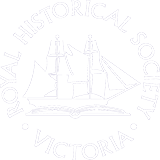The RHSV’s Guide to the establishment and operation of historical societies now known as the Guide for managing historical societies has been available since the 1980s. It is being updated and reviewed in 2021.
The local history world continues to evolve with technology like online catalogues, digitisation and webinars changing some of the ways historical information is accessed and shared.
This Guide will direct you to resources to assist in the setting up and running of historical societies. The content, references and examples have been selected because of their relevance to historical societies.
Historical societies are as diverse as the history they collect, record and interpret. Each society will need to consider the Guide as it applies to its circumstances. The aim is for historical societies to be able to reach out to their communities; making their research, collections and programs accessible and so contribute to the community’s interest and excitement in the history of Victoria.
Articles
Managing the organisation
Incorporation – Model Rules – Roles of Office Bearers – Mission Statement
Planning – Strategic Plan/Forward Plan – Business Plan
Notes for Treasurers plus Income Generation
Computers and historical societies
Involving people
Is the organisation ready for additional volunteers?
Community engagement (Interpretation, Publications, Working with schools, Heritage trails, Cultural tourism)
Style guides for local history publishing
Website design and maintenance
Communication – email, forums and mc2
Developing a significant collection
Safe storage of collection items
Conservation and Collection Management Plans
Provenance – Significance – Preservation surveys
Indexing for historical societies
Bibliography
Policies, Procedures, Guidelines and Forms
The following sample policies, procedures, guidelines and forms are provides as guides only to assist groups preparing documents for managing their own collections
Policies
Sample collection policy for artefacts
Sample collection policy for a research collection
Sample grievance or complaints policy
Procedures and Guidelines
Sample acquisition procedure for artefacts
Sample acquisition procedure for items in a research collection
Sample deaccession and disposal procedure
Sample copyright, reproduction rights and access rights guidelines
Forms
Recording authorisation for podcasting form
OH&S forms
OH&S audit checklist for volunteers
Emergency evacuation checklist
Risk management forms
Example of a risk management plan
More information examples, checklists and tools
Volunteer forms
Is organisation ready for volunteers? – checklist
Volunteer Co-ordinator’s checklist
Templates
MAP collection policy template (Museums Australia (Victoria))
Developing a conservation plan (Museums Australia (Victoria))
MAP forward planning template (Museums Australia (Victoria))
Links to resources
Museum Management
Fact sheets on museum management (Museums & Galleries NSW)
Museum methods (sections) (Collections Australia Network)
National standards for Australian museums and galleries (National Standards Taskforce)
MAP forward planning template (Museums Australia (Victoria))
Museums and galleries collections law (Shane Simpson)
Legal information for community organisations (pilchconnect)
Guide: Community organisations and Victoria’s occupational health and safety laws (pilchconnect)
Collection management
Information sheets – caring for collections (Museums Australia (Victoria))
Caring for collections (Australian Institute for the Conservation of Cultural Material)
Preserving Australia’s documentary heritage (National Library of Australia)
Conservation information guides (State Library of Victoria)
reCollections: caring for collections across Australia (Collections Australia Network)
Preventative conservation fact sheets (Museums & Galleries NSW)
Guidelines for environmental control of cultural institutions (Collections Australia Network)
Safe in the shed: caring for historic farm machinery (Collections Australia Network)
Conservation standards, policies, strategies and guidelines (Collections Australia Network)
MAP collection policy template (Museums Australia (Victoria))
Developing a conservation plan (Museums Australia (Victoria))
Cataloguing
Small museums cataloguing manual (Museums Australia (Victoria))
Cataloguing guidelines for historical societies (blog)
Indexing
Australian and New Zealand Society of Indexers
Significance
Significance 2.0: a guide to assessing the significance of collections (Collections Australia Network)
Significance training (Collections Australia Network)
Digitisation
Creating and keeping your digital treasures – a user guide (State Library of Western Australia)
Image digitisation of local history collections (State Library of Victoria)
Guidelines for digitization projects (International Federation of Library Associations)
Copyright and cultural institutions: guidelines for digitisation (Centre for Media and Communications Law – University of Melbourne)
Electronic media collections care for small museums and archives (Canadian Conservation Institute)
Capture your collections – a digitisation course for remote and regional museums and galleries(Collections Australia Network)
Information technology for local history – digitisation (blog)
Copyright
Copyright and cultural institutions: guidelines for digitisation (Centre for Media and Communications Law – University of Melbourne)
Copyright in cultural institutions
Websites
Designing and maintaining websites
Exhibitions
Creative volunteering: work with collections (Volunteering Australia)
Exhibition fact sheets (Museums & Galleries NSW)
Significant events (Collections Australia Network)
MAP interpretation policy template (Museums Australia (Victoria))
Display interpretation and writing (History Trust (South Australia))
Box making
Box making fact sheet (Museums & Galleries NSW)
Volunteers
Victoria’s Volunteering Portal
Volunteers fact sheets (Museums & Galleries NSW)
Willing and able (Museum & Gallery Services Queensland)
Disaster preparedness
Be prepared: guidelines for small museums for writing a disaster preparedness plan (Collections Australia Network)
DISACT – disaster recovery planning weblinks (DISACT)
Disaster support
Arts Victoria’s Disaster Response Protocol (pdf 243 kb)
Australian Institute for the Conservation of Cultural Material
Bushfires … Protect your precious possessions
How do I salvage flood-damaged records National Archives of Australia
Networking
Building a better relationship with your local council (Chris Brophy – MA Conference 2004)
Tourism
Tourism with integrity (Collections Australia Network)
Successful tourism at heritage places (Collections Australia Network)
Access
Fact sheets on access (Museums & Galleries NSW)
Improving access to heritage buildings (Australian Heritage Commission)
Aboriginal items in collections
Information for Victorian museums with Aboriginal collection items (Museums Australia (Victoria))
Resources for Victorian museums with Aboriginal collection items (Museums Australia (Victoria))
Conservation of indigenous objects (Collections Australia Network)

 239 A'Beckett Street Melbourne, Victoria, 3000
239 A'Beckett Street Melbourne, Victoria, 3000  03 9326 9288
03 9326 9288  office@historyvictoria.org.au
office@historyvictoria.org.au  Office & Library: Weekdays 9am-5pm
Office & Library: Weekdays 9am-5pm

